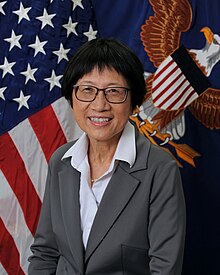
The Defense Science Board (DSB) is a committee of civilian experts appointed to advise the U.S. Department of Defense on scientific and technical matters. It was established in 1956 on the second Hoover Commission's recommendation.

Edward "Pete" Cleveland Aldridge Jr. is an aerospace engineer and former government official in the U.S. Defense Department. He was also selected as a payload specialist for the Space Shuttle mission STS-62-A, scheduled to launch in July 1986. The mission was canceled after the Space Shuttle Challenger disaster in January 1986, and Aldridge never flew.

The Office of the Secretary of Defense (OSD) is a headquarters-level staff of the United States Department of Defense. It is the principal civilian staff element of the U.S. Secretary of Defense, and it assists the Secretary in carrying out authority, direction and control of the Department of Defense in the exercise of policy development, planning, resource management, fiscal, and program evaluation responsibilities. OSD is the Secretary of Defense's support staff for managing the Department of Defense, and it corresponds to what the Executive Office of the President of the U.S. is to the U.S. president for managing the whole of the Executive branch of the federal government.

The United States under secretary of defense for policy (USDP) is a high level civilian official in the United States Department of Defense. The under secretary of defense for policy is the principal staff assistant and adviser to both the secretary of defense and the deputy secretary of defense for all matters concerning the formation of national security and defense policy.
The Assistant Secretary of Defense for Networks & Information Integration (ASD(NII)) was an appointed position that provided management and oversight of all DoD information technology, including national security systems. The ASD(NII) also served as the chief information officer (CIO) of the United States Department of Defense (DoD), a position distinct from the ASD and governed by the Clinger-Cohen Act.
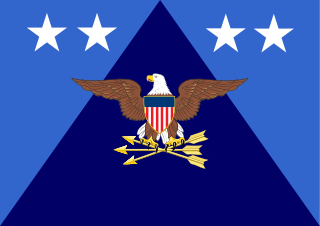
The under secretary of defense for personnel and readiness, or USD (P&R) is a high-ranking civilian position in the Office of the Secretary of Defense (OSD) within the United States Department of Defense responsible for advising the secretary and deputy secretary of defense on recruitment, career development, pay and benefits, and oversight of the state of military readiness. The under secretary is appointed from civilian life by the president and confirmed by the Senate to serve at the pleasure of the President.
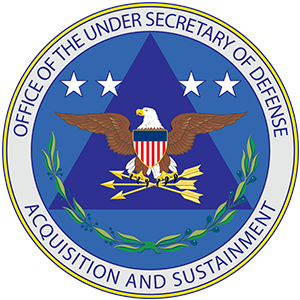
The Under Secretary of Defense for Acquisition and Sustainment, or USD (A&S), is the Principal Staff Assistant (PSA) and advisor to the Secretary of Defense for all matters relating to acquisition and sustainment in the Department of Defense. This includes the DoD Acquisition System; system design and development; production; logistics and distribution; installation maintenance, management, and resilience; military construction; procurement of goods and services; material readiness; maintenance; environment and energy resilience ; utilities; business management modernization; International Armaments Cooperation, Cooperative Acquisition and International Agreements, Promoting exportability of military components to allies and partners; nuclear, chemical and biological defense programs; and nuclear command, control, and communications.

The Assistant Secretary of the Air Force (SAF/AQ) is a civilian position in the Department of the Air Force that is appointed by the president of the United States and confirmed by the United States Senate. This position is established under Title 10 US Code Section 9016 and is one of five Assistant Secretary positions under the Secretary of the Air Force. The Assistant Secretary reports to the Secretary of the Air Force.
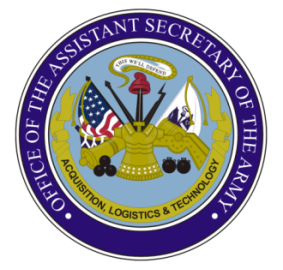
The Office of the United States Assistant Secretary of the Army for Acquisition, Logistics, and Technology (ASA(ALT) pronounced A-salt) is known as OASA(ALT). OASA(ALT) serves, when delegated, as the Army Acquisition Executive, the Senior Procurement Executive, the Science Advisor to the Secretary of the Army, and as the senior research and development official for the Department of the Army. The OASA(ALT) also has the principal responsibility for all Department of the Army matters related to logistics.
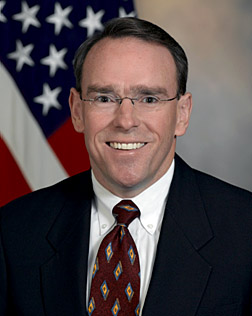
John Jacob Young Jr. was United States Assistant Secretary of the Navy from 2001 to 2005 and Under Secretary of Defense for Acquisition, Technology and Logistics from 2007 to 2009. He is the founder and principal of JY Strategies, LLC.
The Assistant Secretary of Defense for Global Strategic Affairs, or ASD(GSA), is a position in the Office of the Secretary of Defense that develops policy for the Secretary on countering weapons of mass destruction, nuclear forces and missile defense, cyber security and space issues. ASD(GSA) is currently tasked with three major congressionally mandated reviews: the Nuclear Posture Review, the Ballistic Missile Defense Review, and the Space Posture Review. In addition, GSA is the Defense Department's lead in developing the DoD's cybersecurity strategy, and for crafting the policy for the standup of the new Cyber Command. ASD(GSA) answers to the Under Secretary of Defense for Policy. Although ASD(GSA) is a recently configured office, its functional responsibilities can be traced back in part to a position eliminated in early 2008, the 'Assistant Secretary of Defense for International Security Policy'
The Assistant Secretary of Defense for Special Operations/Low-Intensity Conflict or ASD(SO/LIC), is the principal civilian advisor to the U.S. Secretary of Defense on special operations and low-intensity conflict matters. Located within the Office of the Under Secretary of Defense for Policy, the ASD(SO/LIC) is responsible primarily for the overall supervision of special operations and low-intensity conflict activities. These activities, according to USSOCOM's 2007 Posture Statement, include counterterrorism; unconventional warfare; direct action; special reconnaissance; foreign internal defense; civil affairs, information operations, psychological operations, and counterproliferation of WMD.
The Assistant Secretary of Defense for Readiness and Force Management, or ASD(R&FM), is a Defense Department position responsible for civilian and military personnel policy, readiness of the force, military community and family policy and diversity management and equal opportunity.

The Assistant Secretary of Defense for Sustainment (ASD(Sustainment)), formerly known as the Assistant Secretary of Defense for Logistics and Materiel Readiness (ASD(L&MR)), is one of three assistant secretaries reporting to the Under Secretary of Defense for Acquisition and Sustainment. Formerly the position was an adviser to the Under Secretary of Defense for Acquisition, Technology and Logistics, Deputy Secretary of Defense, and Secretary of Defense on logistics and materiel readiness issues within the Department of Defense (DoD), including programs related to logistics, materiel readiness, maintenance, strategic mobility, and sustainment support. As the principal logistics official within the senior management of the DoD, the ASD(Sustainment) exercises authority, direction and control over the director of the Defense Logistics Agency. Like all other Assistant Secretaries of Defense, the ASD(Sustainment) is considered a part of the Office of the Secretary of Defense.

The Assistant Secretary of Defense for Energy, Installations, and Environment, concurrently the Chief Sustainability Officer, and formerly known as the Deputy Under Secretary of Defense for Installations and Environment, provides management and oversight of military installations worldwide and manages environmental, safety, and occupational health programs for the Department of Defense (DoD). DoD's installations cover some 29,000,000 acres (120,000 km2), with 539,000 buildings and structures valued at more than $700 billion. The responsibilities of the ASD(EI&E) include the development of installation capabilities, programs, and budgets; installation-energy programs and policy; base realignment and closure; privatization of military housing and utilities; and integration of environmental needs into the weapons acquisition process. The ASD(EI&E) is also responsible for environmental management, safety and occupational health; environmental restoration at active and closing bases; conservation of natural and cultural resources; pollution prevention; environmental research and technology; fire protection; and explosives safety. The ASD(EI&E) reports to the Under Secretary of Defense for Acquisition and Sustainment, and is a part of the Office of the Secretary of Defense.

Assistant Secretary of Defense is a title used for many high-level executive positions in the Office of the Secretary of Defense within the U.S. Department of Defense. The Assistant Secretary of Defense title is junior to Under Secretary of Defense. Reorganization Plan No. 6 of 30 June 1953 increased the number of assistant secretaries. The list of Assistant Secretaries of Defense includes:

The United States Army Acquisition Corps (AAC) is the officer / NCO corps of the United States Army Acquisition Workforce (AAW), a branch which includes civilians, officers, and NCOs. The Acquisition Corps is composed of army officers who serve in acquisition, a specialized form of product development, fielding, and support and Noncommissioned Officers who specialize in Contracting, Level I Program Management and Purchasing. These officers begin their careers in the other branches of the army for eight years, after which they may elect the Acquisition branch as their career as assistant program managers (APMs), program managers (PMs), and program executive officers (PEOs). The Noncommissioned Officers (NCOs) are reclassified in the Army Acquisition NCO Corps after serving 7-10 years in their respective enlisted career management fields, and serve primarily in the Army Acquisition Career Management Field - 51 and (MOS) 51C. 4% percentage of the Army Acquisition Officers serve among the 40,000 members of the army acquisition workforce, 6% in MOS 51C - Acquisition, Logistics and Technology Contracting Noncommissioned Officer, and the remainder 90% percentage consist largely of Department of the Army civilians.

William B. Roper Jr. is an American physicist and foreign policy strategist who served as the 13th Assistant Secretary of the Air Force for Acquisition, Technology and Logistics, overseeing procurement for the U.S. Air Force and Space Force from 2018 to 2021. Before taking office he served elsewhere within the Department of Defense as founder and director of the Strategic Capabilities Office, and prior as Ballistic Missile Defense System Architect at the Missile Defense Agency. He was also a member of the 2018 National Defense Strategy steering group. He is currently the CEO at Istari, as well as serving as senior advisor at McKinsey and Co., and teaching at Georgia Tech.

The Assistant Secretary of the Air Force for Space Acquisition and Integration (SAF/SQ) is a civilian position in the United States Department of the Air Force that is appointed by the president of the United States and confirmed by the United States Senate. This position is established under Title 10 US Code Section 9016. The assistant secretary reports to the Secretary of the Air Force.

The Assistant Secretary of Defense for Acquisition, or ASD (A), is one of three assistant secretaries reporting to the Under Secretary of Defense for Acquisition and Sustainment. The position is the principal advisor to the Under Secretary of Defense for Acquisition and Sustainment, the Deputy Secretary of Defense, and the Secretary of Defense on matters relating to acquisition program management; the Department of Defense Acquisition System; and the development of strategic, space, intelligence, tactical warfare, command and control, and business systems.

